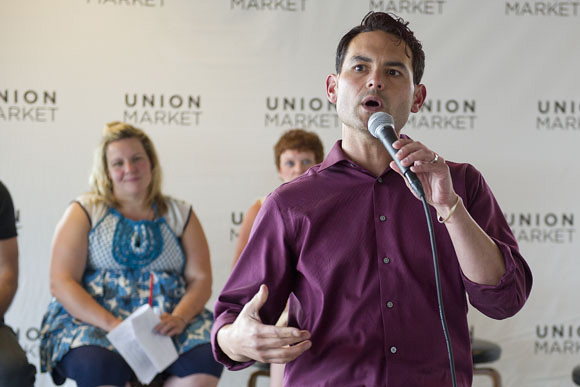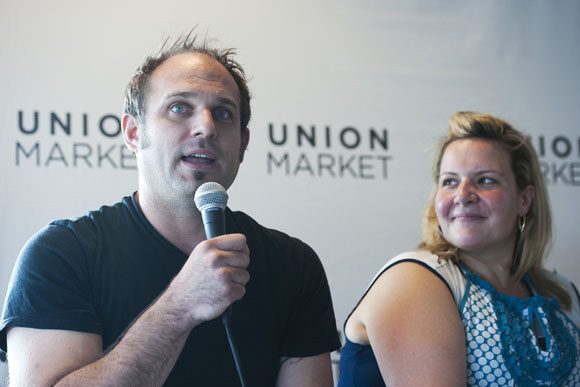It was standing room only at the Food in the City event at
Union Market on June 20, where a short panel discussion set the stage for plenty of food-and-drink-fueled conversations among the 125 attendees.
Che Ruddell-Tabisola, owner-operator of
BBQ BUS DC, kicked off the panel with a reference to the latest food truck regulations — a compromise with the City Council and brick-and-mortar restaurants that most see as a step in the right direction.
But the political director for the
D.C. Food Truck Association didn’t dwell on the politics of mobile vending. Instead, he pointed out its virtues — and its role in an ever-evolving food community.
“They’re a great use of public space,” he said, listing off corners of the city where federal complexes are surrounded by national parks or blighted areas that otherwise lack eating options.
It’s the kind of conversation the event’s organizers, Elevation DC and
Smart Growth America, were hoping to spur through this second in a series of panel discussions about the intersection of place and economy.
How are food businesses changing spaces and creating communities, and how can the city continue to develop the industry’s growth?

Ruddell-Tabisola said food trucks have brought both food and personality to some otherwise unused — or, in the past, unsafe — areas, helping to transform them, “because well-used streets are safe streets.”
And that’s not to mention their role in incubating the next generation of cooks and business owners.
“How have food trucks helped start-ups?” Ruddell-Tabisola asked. “You look at the history of this country — there were street vendors before there were restaurants. That continues today.”
Stacey Price, Executive Director of
Think Local First DC, an organization with nearly 430 businesses in its network, agreed.
“What we know is that the independently-owned food businesses in this community are the fastest growing sector of independent businesses,” said Price, whose group also works to connect those businesses with local products to use in their kitchens.
She told Gina Chersevani, owner and mixologist at
Buffalo & Bergen, who catered the event and was sitting next to her, that she’d like to help her find local sources for, say, a piña colada.
�Show me the coconuts."
Chersevani’s eyes got big and Price seemed to realize she could have picked an easier example.
“Show me the coconuts,” Chersevani said.
The challenging of sourcing locally foods that don’t grow here year-round (or at all) was later raised again by an audience member, who asked how to maintain quality standards as the food system moves toward using more local ingredients more often.
Richie Brandenburg, a long-time chef turned culinary curator for Union Market and other
EDENS developments, said it comes down to preservation—pickling, canning and more—and to people “walking the walk.”
“If we preserve things in a better fashion, I think that’s a start to maintaining a local standard,” Brandenburg said, pointing out Woodberry Kitchen chef-restaurateur Spike Gjerde as an example of someone who’s leading the commitment to all-local foods by preserving produce for winter use.
 Brandenburg said Americans need to realize that sometimes the best products, in places like Spain and France, come out of cans.
Brandenburg said Americans need to realize that sometimes the best products, in places like Spain and France, come out of cans.Brandenburg said Americans need to realize that sometimes the best products, in places like Spain and France, come out of cans. They’re picked and preserved at their seasonal peak — and that’s something that could be done here, he said.
Beth Kanter, co-moderator of the event and author of
Washington DC Chef’s Table and
Food Lovers’ Guide to Washington, D.C., said canning and other preservation methods are beginning to take root in D.C. neighborhoods, “at a micro level.”
Another thing beginning to take root in D.C.? The people.
Chersevani, who’s also a partner in
Hank’s Oyster Bar, said she’s seen the city’s population change from transients who leave with each administration to families that have started to stay in the last decade.
And she said a lot of that has to do with the brand of community that forms around eating. At Buffalo & Bergen’s Union Market location, she’s seen people who live on a nearby street meet their neighbors for the first time at her bar.
“In restaurants you provide a hospitable environment,” Chersevani said. “It’s that whole conversation that starts with, ‘Hello.’”
Price agreed that the local food vibe plays a big role in convincing people to stay in D.C. and “changing the way creatives are seeing our city.”
“Everyone talks about how D.C. is this transient place. I’d like us all to change our messaging on that,” Price said. “What if we said, ‘D.C.’s a great place to raise a family, to stay’?”